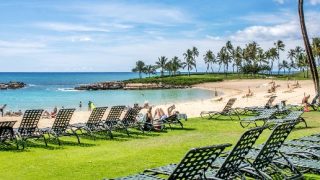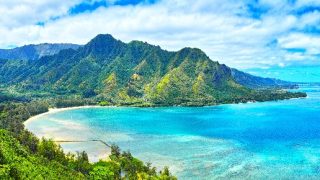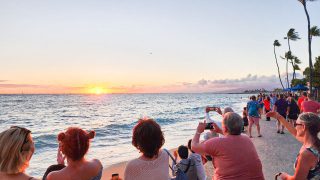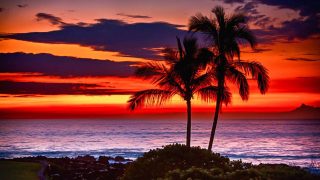Here’s how America’s never-ending infatuation with Hawaii happened and then went into hyperdrive in the 1960’s, following statehood in 1959. With that, travel and all things Hawaii became glamorized in the U.S. and worldwide thanks to marketing.
Hula dancers, aloha wear, tiki torches, Ukelele, slack-key guitars, and Hawaii-themed movies and TV shows became the rage. It honestly has never stopped, which is good news for our state’s economy. Today’s post gives you a retro look at the past and we hope you’ll add your memories too.
Our love of Hawaii travel went nuts starting in 1959 with the advent of jet travel.
Tourism began in earnest, which was to be turbocharged with the nearly simultaneous introduction of jet aircraft. Pan Am started the age of Hawaii jet travel, using Boeing 707 aircraft, just a month after Hawaii became a state. That reduced travel time to the islands almost in half, and it allowed airlines to transport more passengers at a fare lower cost than was ever possible.
One vintage United Airlines advertisement described Hawaii as “painted in every hue of the rainbow, flavored to every taste, guaranteed to relax. All you need to do is choose your island,” it declared. “The aloha spirit will do the rest.”
Before jet travel, a roundtrip ticket was $4,000 in today’s dollars. You can imagine how much money that was in the 1940’s and even today.
Interesting fact: Did you know that Hawaii was first promoted in print in a magazine named Paradise of the Pacific, which first appeared in 1888 with the blessing of King Kalākaua ? That later became the well-known Honolulu Magazine. As such, it’s one of the oldest periodicals in the U.S.
What Hawaii was like before tourism of the 1960’s.
The sugar and pineapple industries were responsible for most of the income for Hawaii. But starting with jet travel, there was a massive increase in visitors to the islands. In the 1960s, visitor arrivals went from less than 300k annually to nearly 2 million.
Going back even further, before the 1900s, the only visitors to Hawaii were adventurers, sailors, whalers, and some scientists. “The loveliest fleet of islands,” and “The Grand Canyon of The Pacific” were two Hawaii quotes attributed to Mark Twain. The U.S. annexed Hawaii in 1898, and with that visitors began slowly to arrive by ship. In the 1930’s Pan Am began flying to Hawaii, bringing with it Hawaii luxury travel.
To support the explosive growth in Hawaii’s tourism industry, a construction boom closely followed. Hotels, restaurants, and apartment buildings all needed to be built to support burgeoning travel.
Role of Elvis Presley in Hawaii boom and Blue Hawaii.
Elvis loved Hawaii and Hawaii loved him back. The short-lived “King of Rock and Roll” star and singer was one of the most important cultural icons of the 20th century, and remains so to this day.
“Everyone who knew him says there were only two places Elvis felt at home, and they were Memphis and Hawaii.” That according to Elvis biographer Jerry Hopkins. Elvis, in fact, starred in three movies filmed in Hawaii in the 1960s, “Blue Hawaii” filmed at Kauai’s Coco Palms Resort, “Girls! Girls! Girls!,” and “Paradise, Hawaiian Style.”
Television and Hawaii Five-O.
As if Hawaii needed more fame and attraction, the islands were featured in the hugely popular TV series Hawaii Five-O, which helped cement the young state as an aspirational vacation destination for the rest of the country.
Hawaii Five-O on CBS ran from 1968 to 1980, and reruns continue to this day. Plus, the revamped version that started in 2010 and ran for 10 seasons. The original became the longest-running and most famous police drama ever. Featuring Jack Lord as Detective Captain Steve McGarrett, who headed the special state police task force in Hawaii. It was based on a real police unit that existed following WWII. The theme music from the show became as famous as the show itself. “Book ’em, Danno!”
And it wasn’t just Hawaii Five-O. There’s a legendary “Brady Bunch” special featuring the family’s 1972 trip to Hawaii. “How can they land such a big plane on such a little island?”
Aloha wear: the ultimate Hawaii fashion statement.
With the allure of Hawaii in everyone’s mind, it didn’t take long for the spark of Hawaii’s themed aloha wear to take hold elsewhere. Aloha wear started to take hold. While the origins of aloha wear aren’t completely clear, they were first seen in Hawaii before 1930, when it’s thought that Japanese women altered kimono fabric to be used in men’s shirts. Almost immediately, aloha shirts achieved traction with tourists to Hawaii. They became widely seen on the mainland starting in the 1930s. Fast forward thirty years when Elvis Presley became a fashion giant in the movie Blue Hawaii.
Part of the allure of aloha wear was that those struggling financially on the mainland in the 1930’s, started wearing them to be like the rich and famous who could afford to travel to Hawaii.
Other stars, from Hawaii’s own surf legend Duke Kahanamoku to Bing Crosby, both ported aloha shirts and became part of aloha wear brands. Those endorsements of Hawaii’s care-free attire, were another boom to both aloha wear and to Hawaii tourism.
Following WWII, aloha wear was transformed from largely Japanese designs to what we know as aloha wear today, which features Hawaii culture.
Aloha Fridays in the workplace added to aloha shirts’ popularity. Even President Richard Nixon wore one.
Through a series of ebbs and flows, the shirt has had a comeback that remains strong to this day. Kahala, which dates back 85 years, was one of the first major brands to launch.
Pearl Harbor/Arizona Memorial
Two decades following the attack on Pearl Harbor, the Arizona Memorial was erected, helped by a large gift from Elvis Presley. It opened in 1962 in honor of the 2,500 who died during those attacks. The memorial is the most popular visitor attraction in Hawaii, to this day.
Surf Culture that started with the Beach Boys.
The 1960’s saw the blooming of Hawaii’s surf culture. The Beach Boys helped with that with their “Let’s go surfing now, everybody’s learning how.” The culture reverberated in nearby Southern California, and with it came not only surfing, but skateboarding, together with beach attire including much of it Hawaii-themed. Surf movies were all the rage too, such as Endless Summer, which helped further the Hawaii surf industry.
Music from Hawaii became all the rage.
It began to be all the rage starting in WWI. In 1916, Hawaiian music sold more recordings on the mainland than any other genre. With that came the range of Ukulele and Slack-key. Diverse Hawaii music ranges from modern, folk, native, traditional, and popular. Ukulele and slack-key guitar are renowned worldwide. Hawaiian music a regular part of Hollywood soundtracks. Traditional Hawaiian music includes chanting (mele) and music meant for dance (hula). It represents the mix of cultures seen on the islands.
Ancient Hawaiian music is still heard in modern day rhythms, chants, vocals, and percussion instruments. It is both simple, reverent, and chicken-skin haunting. Some also emanated from the influence of missionaries who started arriving in 1820.
Fascinating: United Airlines Hawaii Flights Began With DC-6 Glamor; $4,000 Tickets
What period do you remember most about Hawaii? Please share your memories below.







I much enjoyed the history lesson on the Aloha wear. The article was great.
Mahalo
Hi Roy.
Thank you!
Aloha.
After viewing the video, I realized it was filmed at Hickam. I imagine those soldiers were returning from Asia (Vietnam). I know Pan Am did many military charters, they were fantastic. Took them many times between Portland/Seattle and Honolulu during my college years. Of course cabin service was so different during that era.
Our first trip to Hawaii was in 1963. Flew Pan Am and remembered receiving leis when we landed (free!). Toured over the Arizona on a small boat. Cameras were not allowed then. I remember my dad checking out condo prices for $20,000 and thinking that was too much. I wish he would have bought one! I’ve seen lots of changes over the years. My favorite picture is Ka’anapali Beach looking south from the Sheraton with no hotels/timeshares on it. I miss the old Rusty Harpoon at Whaler’s Village. (The original one that was on sand in a shack, not the restaurant that later was built.) I miss the original Fleming’s Beach, too. We still return almost every year to continue the tradition.
My mother worked for Matson Steamship Co and my father was a pilot in the Air Force based @ Hickman. They met and married in Honolulu and were married in 1956. Mom lived in a cottage on Gray’s Beach. In the mid 60s when I was probably 7 or 8 we traveled to Hawaii and stayed in that cottage. Dad was by then a pilot for TWA. We visited with some of there friends who were still there and had lunch @ the OCC. It was magical. I remember that trip as fondly as going to Disney.
Aloha Rob &Jeff.
I can truly understand not only America, but the world’s love of the Islands. Sadly sitting in LAX awaiting my flights back to Ireland after a truly wonderful stay in Maui. But my love also extends to Kaua’i, Oah’u and the Big Island, each with their own heartbeat and beautiful sights and sunsets to see. Can’t wait to save up and get back..
Yes, the Arizona Memorial, the Iolani Palace, the Road to Hana, the Volcano and the Na Pali Coast are all must sees and wearing the obligatory Aloha shirt adds to the enjoyment. The genuine warmth of the people who happen to live in the loveliest place in the world makes this long trip so worthwhile.
So never goodbye, but A hui hou.
Mahalo as ever to you.
Hi Michael.
Thanks. We’re awaiting your return!
Aloha.
Hi guys, I took a Northwest Orient 747 to Honolulu in the 70’s. Smoking and roaming were allowed on the plane and it was a real party atmosphere. Oahu was not crowded as it is now.Stayed at Pupakea above Sunset beach w/friends. Very low key local atmosphere. Kauai was even better. Baggage claim on the tarmac on a wooden bench w/a that he’d palm roof. Talk about tropical. Fell in love at first sight. Still am.
The 70s in Maui. Sandy roads to Makena where people would get stuck and you could be the only one on the beach. Azekas store bring the only place you could get groceries on south side of the island. And of course OGG as an open air airport with the banyan tree. ❤️😢
Would give anything to go back to those amazing quiet days on the island.
I agree with other comments made; that the 70’s were amazing; even with the tourism of that time when Waikiki Beach was crowded, but not overcrowded, when you could meet newlyweds from different parts of the world…as a kid at the time, it felt integrated, somehow. Now, I live abroad and when I go home, I tend to stay near what was Kuilima. I wish government could do two things that it is meant to govern the people of the islands with their best interest in mind and regulate the industries (including tourism and # of people allowed in a revolving manner [stop building more!])to satisfy the business owner’s and the people in the islands! What a conundrum, but what is telling is that during COVID-19’s first months, sealife/coral returned!
I think Magnum PI would be a part of this story too. Though not about Hawaii specifically, it was a lifestyle show that had a lot of influence.
My favorite era in the Islands were the 60’s/70’s when relatively few came to Kauai. Remember fondly the charming little interisland terminal. Oh for the good old days!